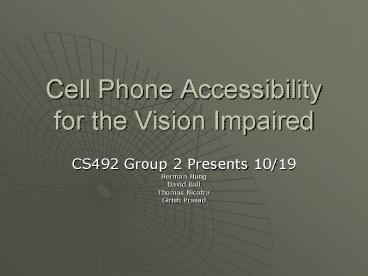Cell Phone Accessibility for the Vision Impaired - PowerPoint PPT Presentation
1 / 15
Title:
Cell Phone Accessibility for the Vision Impaired
Description:
Applies to all telephone equipment and services at home, at ... Screenless functionality. Speech-synthesis software. Searchable phone book. SMS Text Messaging ... – PowerPoint PPT presentation
Number of Views:63
Avg rating:3.0/5.0
Title: Cell Phone Accessibility for the Vision Impaired
1
Cell Phone Accessibility for the Vision Impaired
- CS492 Group 2 Presents 10/19
- Herman Hung
- David Ball
- Thomas Nicotra
- Girish Prasad
2
What is our project?
- Improving cell phone accessibility for the
visually impaired - No large projects in progress
- Variety of different solutions
- Should be available for everybody
3
Why do it?
- Section 255!
- http//www.afb.org/Section.asp?SectionID4Documen
tID1536 - Congress amended telecommunications law in 1996
in order to mandate accessibility to telephones
for those that are impaired - Applies to all telephone equipment and
servicesat home, at work, and on the go! - Does not cover e-mail and Internet accessibility
- Helps communication
- Visually impaired friends or relatives? No
problem! - Emergency availability for the visually impaired
(911, hospital, pharmaceutical applications) - Convenience that allows all people to use a
mobile phone
4
Guidelines The Sweet 16
- American Foundation for the Blind Survey
- Top 16 features that visually impaired cell phone
users are looking for - Many of these have not been implemented in
todays modern cell phones - Most implemented through software solutions
5
Current Solutions
- Owasys (Oasis) 22C cell phone
- Cell phone designed specifically for the blind
- Screenless functionality
- Speech-synthesis software
- Searchable phone book
- SMS Text Messaging
- Vibrating ring
- Text to speech on special cell phones (Nokia
6620) through SMS messaging service or push
type e-mail - Expensive Mobile Accessibility Software (Must be
loaded onto the phone, not downloaded)
6
Whats the Problem?
- Whats the problem with current solutions?
- Expensive
- Not widely available
- Do not integrate many of the features of the
sweet 16 in every cell phone - Many still in development phase
- Not really touted as a main feature
7
Our Goal
- Development of a simple, accessible solution
- Must be available on the latest phones
- Must not be limited to specialized phones /
software packages - Must be easy to use
- Must be accessible to all visually-impaired
people (not just low-vision)
8
Goals
- Main Goals
- Establish a way to read off battery life
- Number 4 on the sweet sixteen
- Extremely critical to visually impaired people
- Roaming
- Number 5 on the sweet sixteen
- Avoid those nasty roaming charges
- Signal Strength Indication
- Number 13 on the sweet sixteen
- Not so critical, yet very handy
9
Goals Continued
- Secondary Goals
- Missed Calls
- Number 6 on the sweet sixteen
- Important if critical calls are missed while in a
meeting or in CS492 class - Text-to-speech Phonebook
- Number 7 on the sweet sixteen
- Hardest to implement
- Easiest way to dial (we use it all the time)
10
How are we going to do it?
- Audio indicators
- Easier to implement, not as nice
- Non-specific indication no numbers
- Text-to-speech Synthesizer
- Harder to implement
- Harder to find (more uncommon)
- Vibrating
- Solution for noise
- Annoying and non-precise
11
The Tech Stuff
- Motocoders.com
- Motorola SDK v5.2.1 for J2ME
- The latest SDK in existence for the latest phones
- Works with J2ME technologies by Sun Corporation
- Java Time
- J2ME Java 2 Platform, Micro Edition
- Works with embedded systems architecture
particularly micro devices such as cell phones,
pagers, and PDAs - Layers with technologies such as CLDC (Connected
Limited Device Configuration) and MIDP (Mobile
Information Device Profile)
12
J2ME
- A series of packages, configurations, and
profiles that mesh to form a complete Java
environment - CLDC and MIDP are the most commonly used support
elements - Hosting environment for code work
- Four Application Layers of Development
- Traditional Application Model
- Applet Model
- MIDlet Model
- Xlet Model
13
Models Overview
- Traditional Application Models
- Supported by CLDC
- Most robust model terminating at user request
- Easy Switching between application models
- Applet Model
- Embedded Application under control of web browser
- Managed application terminates through web
browser - MIDlet Model
- Mobile Information Device Profile (MIDP)
application - Managed by AMS (Application Management Software)
built into the device - Xlet Model
- More robust than MIDlets, able to abort its own
destruction - More complex than necessary
- We are dealing mostly with MIDlets and possibly
Xlets to develop applications for reading user
input, then producing necessary outputs
14
Design Process
- Analysis of methods
- Button pushing versus audio commands
- What do the users want?
- Development of applications
- Testing on MIDP supported emulator
- Download and testing on phones
- Push to final stages
- Delivery
15
THE END
- Wasnt that fun?
- Additional resources
- http//java.sun.com/products/midp/overview.html2
- http//java.sun.com/products/cldc/index.jsp
- http//java.sun.com/j2me/index.jsp
- http//www.afb.org































